
Atlas F1 Senior Writer
The Second US Grand Prix at Indy was an extraordinary event - for Formula One and for the local hosts. It was different from the inaugural race last year, and yet it was the same. Thomas O'Keefe, who virtually grew up at the Speedway, spent the weekend in the backstage of the Grand Prix, patrolling through the Paddock, Pitlane and Media Center. He brings back impressions and anecdotes, including a personal message from Mika Hakkinen to the Atlas F1 readers
The Second Time Around at Indy it was different, since the drivers and the teams knew better what to expect, but when the race weekend was over you got the sense that Indy had passed some sort of unspoken test, and that Formula One would be coming to Indy for many years to come.
The success of this second race - approximately 175,000 people came, making the US Grand Prix the best attended Formula One race for the second time in two years - was against all odds, given the fact that Americans were still in a state of sorrow and disbelief at the events of September 11th, with airplanes flying half empty and American flags flying at half staff throughout the country. In addition, the fact that Michael Schumacher and Ferrari had already wrapped up both the Drivers' and Constructors' Championship well before Indy also promised to reduce the size of the crowd, since less was at stake than last year, when the Championships were still in contention.
I have been to Indianapolis many times over the years, usually in Turn 4 for the Indy 500, where my extended family has had a block of 25 seats for the last 20 years. But for this race, I found myself happily ensconced in what I think of as the Perfumed Stockade - the Paddock, the Pitlane and the Media Center - and what I saw there was a fascinating snapshot of where Formula One is at just this moment and how the players relate to one another as the 2001 season winds down.
Starting with the drivers, I have the pleasure of carrying a personal message to Atlas F1 readers from the Flying Finn - retiree and race winner Mika Hakkinen, who, when I saw him in the paddock before Friday Practice remembered my Hakkenheim article (he calls me "Mr. Internet," in broken Finnglish). "I am going away for a year," he told me - as if I did not know. "Give your readers a big hug from me." So consider yourselves hugged.
Throughout the weekend, when he turned 33 years old, Mika's relaxed manner was palpable to everyone, permitting him to transcend the many miscues of the weekend that came his way - an off during practice, an engine that needed replacing and the controversial penalty imposed by the FIA of consigning him to fourth place on the grid for running a red light in Indianapolis (at the racetrack!). In effect, on Indy weekend, he was a free man in the land of the free, and he seemed to enjoy his US Grand Prix victory at Indy more than most of his other 19 victories, which used to come so easily but have recently proved to be hard and dear.
Uniquely for him, Mika was actually funny at one of the press conferences after the race, explaining his reasons for retirement, in response to a question as to his rivalry with Michael Schumacher all these years. "That's why I am leaving, because he paid" - pained? - remember this is Finnglish - "me too much, you know. I can't handle it anymore. (Laughter). Now even his brother [Ralf] is coming you know. (Laughter)"
With that, Michael followed suit and, on both days, the fans applauded, waved their flags and chanted "Schumi" or "Mika", as appropriate, while their heroes looked down over the elevated railing to the people clogging up the tunnel entrance, looking for all the world like Roman orators addressing their minions.
Michael had a bright red Vespa scooter supplied by Ferrari for getting around Gasoline Alley; Rubens had one too, both of them with their names stenciled on the flanks of the scooter. Before leaving the interview session by scooter (everyone else walks back to the paddock from the media center), Schumi signed dozens of hats, shirts and programs for the respectful but hysterical Tifosi hanging over the walls and barriers by the FIA press conference room, obstacles that were designed to keep fans at a distance but have happily now failed to do so for two years running.
At the other end of the grid, the Minardi drivers - 20 year-old Spaniard Fernando Alonso and 25 year-old Malaysian Alex Yoong - stayed close to one another and the team all weekend, either in the garage area or holed up in the Minardi hospitality suite behind a partition where, because of their youth and lack of notoriety, they could easily have passed as public relations assistants or particularly clean-cut mechanics.
Yoong was in only his second Formula One race and made a favorable impression on all concerned; he also has one of the most fabulous looking helmet designs and color schemes in the pitlane, working the sun burst motif of the Malaysian flag into the overall design.
Meanwhile, over at the BMW-Williams hospitality suite, Juan Pablo Montoya, returning to the scene of his remarkable win as a rookie at the 2000 Indy 500, looked comfortable as he geared himself up for Doing the Double - being the first driver to win both the Indy 500 and the US Grand Prix at Indy, his law student girlfriend, Connie, and family along for the weekend, unlike many of the European drivers who were bachelors at Indy.
Frank Williams was wheeled in and out of the hospitality suite as needed, for photo ops and practice and qualifying sessions. Ralf and Michael Schumacher always seem to find themselves talking to fellow German Norbert Haug of Mercedes-Benz on a race weekend and Juan's teammate Ralf was doing a lot of that again at Indy, outside the hospitality suites, keeping in touch, just in case.
Jean Alesi and Jarno Trulli, the Jordan driver duo for at the next two weeks, wandered around the paddock as usual, two people who don't like to be confined to motorhomes and hospitality suites. Alesi at one point inadvertently crossed paths with ex-teammate, ex-friend, ex-team principal and current litigation adversary Alain Prost, and Alesi stuck out his hand in friendship to Prost, who looked taken aback by the gesture but took Alesi's hand anyway and firmly shook it: no words were spoken and Alesi moved on.
The last vestiges of the British Commonwealth amongst Formula One drivers - Scot David Coulthard and Brit Jenson Button (Eddie Irvine is more Irish than British) - had a fascinating exchange just before the race that was revealing of the two men, both among the more gregarious of the driver group.
Notwithstanding Spa 1998, when Michael Schumacher ran into Coulthard at Pouhon in the rain and converted his Ferrari into a three-wheeler, blaming David for the incident, the two men seem on very good terms currently, the way they once were as bachelors in Monaco years ago. At one point in the weekend, there was obviously some discussion between David and Michael about some point that had arisen in the drivers' meeting, possibly Mika's penalty for running the red light in the pitlane, and Schumacher was actually seeking David's view of the matter, in a most collegial and respectful way, as he called over David while jump-starting the Vespa scooter: "that seemed a bit harsh." Coulthard, more like a barrister than a driver, marshaled the arguments back and forth, and Schumacher nodded thoughtfully, as the Vespa sputtered to life.
During this same time period, the Mountain went to Mohammed, as Bernie Ecclestone could be seen making an unusual solo visit to Schumacher in the Ferrari hospitality suite for reasons unknown, after Bernie's aides had sent advance word to Ferrari that Bernie was en route. Although 71 year-old Bernie could be seen flitting around all over on the race weekend - "putting out fires," as he will tell you - it is somewhat unusual for such a visitation. Perhaps he was checking to make sure Michael, in his self-appointed role as Chief Shop Steward for the drivers, was not planning a Rule Book Slowdown for Indy, as Schumacher had tried to orchestrate at Monza.
Speaking of potentates, lanky Tony George and less-lanky Bernie Ecclestone also visited in one of Bernie's two fire-fighting Formula One Management offices to check on the weekend's prospects; it is from the FOM bunker (no Silver Bus is brought for Bernie to the non-European races) that Bernie runs the whole shooting match with only three tools: his walkie-talkie, his wrist watch and his force of personality. Bernie also entertained Jac Nasser, head of Ford Motor Company, in the FOM hospitality suite (smoked glass window, locked doors) who was dressed incognito in Jaguar team garb and could easily have been mistaken for an aerodynamicist!
When the race was over, it was regarded as a "Just" Victory for Mika, as Michael Schumacher called it; indeed, there was an overall sense of Good Feeling that spread through the Perfumed Stockade and a sense of relief that nothing had gone wrong when so much could have, as well as satisfaction that so much had gone right.
At the McLaren-Mercedes suite, the celebration was in full swing for a team that has not had much to celebrate this year. DaimlerChrysler Chairman Juergen Hubbert was justifiably pleased with Mika's win and David's third place finish, and presided outside the hospitality suite in sunny Indy with a cigar and a glass of beer. Jo Ramirez of McLaren, who was retiring after Indy and had been feted at a party the English reporters called "Jo's Do" on Friday night, was already in the party mood and when Mika appeared just outside the McLaren suite, Ramirez and others boosted the slight Finn on their shoulders to the cheers of the crowd. Opera Singer Placido Domingo also made his way into the crowd to pay his respects to the team.
Ron Dennis was inside the hospitality suite for much of this time, meeting with supporters and reporters and - unreconstructed fan that I am - I asked him there to sign my article Mercedes-Benz at Indy, that was included in the Official Program of the US Grand Prix but originally appeared here on Atlas F1. All I had available at that moment was a red pen. Dennis took one look at me and then back at the pen and said, "You're going to ask me to sign this in Red!" But he signed. When Dennis emerged from the hospitality suite, fellow sportsman Patrick Head of the Williams team extended his hand and these two men exchanged the genuinely warm greetings of Happy Warriors loving what they do.
High above the paddock in the upper floors of the distinctive Pagoda tower that is a trademark of the Indianapolis Motor Speedway, guests of Tony George were unwinding from an afternoon of watching the race from a birdseye viewpoint, where the entire track - including the back straight and the infield circuit - can be seen. Max Mosley's FIA suite is also in the Pagoda, but Max stayed in Europe to complete his campaign for re-election as President of the FIA.
And speaking of the racetrack, although the 2001 race was another good one with overtaking here and there at several different corners as well as the drama of slipstreaming from time to time, the drumbeat continued as to the supposed Mickey-Mouse nature of the infield portion of the 2.6 mile circuit and the less-than-death-defying banking, characterized by 23 seconds of nonstop acceleration. This year the outspoken Pedro de la Rosa said the infield section is too short and its corners too slow. "We need to lengthen the track, make it more interesting with a couple of corners, more quicker corners." he said. "If we can use the back straight which, I don't know, would be a very good idea because then you increase the overtaking opportunities."
Jacques Villeneuve had suggested last year that something be done about the last turn before the banking, Turn 11 of the Grand Prix track, which is just inboard of Turn 2 of the oval track. His argument was that if it was a faster turn, it would lead to higher speeds during the 23-second run on the oval and down the front straight to Turn 1 of the Grand Prix circuit. This year Jacques said: "It's a fun track to drive; but, as Pedro was saying, it's not very interesting. There's no corner where your heartbeat goes up. It's more like, you know, playing with go-karts with your friends. That's how it feels a little bit; but, it's good for racing because you have the long straight line, so that's a good thing."
According to reliable sources (my taxi cab driver!) the Indianapolis Motor Speedway is responsive to criticism of the track and over the winter quietly responded to comments made last year by reconfiguring the track slightly. Given the enormous capital costs already invested, understandably the Speedway would like to amortize its costs over at least a few years of racing before making any dramatic changes in configuration of the track. But Tony George and Company have proved before that they listen and learn so don't count out the de la Rosa/Villeneuve solution yet.
As Max Mosley said last year at a press conference held at Indy, the test of whether the US Grand Prix will be a success at Indy will not turn on these first two events. "I don't think there is much question it will work, It's just a question of how long it will take," Mosley said. "I think it will be a major event in 20 years. What it will be in five years, we don't know."
From all the available evidence, it seems that the foothold that Formula One needed in the United States has finally been established at Indianapolis. The same Max Mosley this year was even hinting in the context of scheduling more Grands Prix outside of Europe, that America might even have a second race in the cards, which Ron Dennis assumed would be on the West Coast, but who knows. Back in 1982, incredibly, there were three Grands Prix in the United States, so stranger things have happened. For now, let us be grateful that in the Heartland of America, in a country that stumbled but did not fall on September 11th 2001, the United Nations that is the Formula One fraternity came, saw, raced and left Indiana and the world a better place for having been there.
People react differently to the Indianapolis Motor Speedway when they first encounter it: NASCAR's Bobby Labonte and his crew kneeled down and kissed the yard of bricks at the Start/Finish Line, when Labonte won the 2000 Brickyard 400; Jean Todt's reaction after the qualification session at the Inaugural US Grand Prix at Indy last year was to suggest that perhaps the yard of bricks be ground down a bit to match the smooth asphalt and make for a good launch from a standing start! Mika Hakkinen also commented last year that "you are going to lose traction over those little bumps [the bricks]."
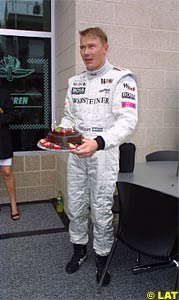 But the reaction of McLaren's principal Ron Dennis, not known as a particularly emotional sort, was more typical of the Formula One brigade. Dennis opined that what he and the crowd seemed to love was the engine note of the high-revving V10 engines at the Speedway, with its towering grandstands on both sides of the narrow track. "the engine note still gives me a tingle," he said, "particularly down a confined place as we have here on the front straightaway."
But the reaction of McLaren's principal Ron Dennis, not known as a particularly emotional sort, was more typical of the Formula One brigade. Dennis opined that what he and the crowd seemed to love was the engine note of the high-revving V10 engines at the Speedway, with its towering grandstands on both sides of the narrow track. "the engine note still gives me a tingle," he said, "particularly down a confined place as we have here on the front straightaway."
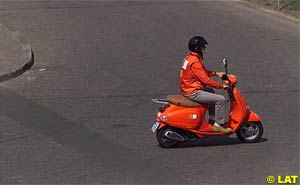 And all weekend Mika had the fan-friendly instincts of a NASCAR driver. As an example, after each of the Qualifying and Post-Race press conferences, Mika and Michael were interviewed by film crews outside the media center behind a cordon of ropes and stanchions located right above one of the pedestrian tunnels running below the track and while the interviews were going on word obviously spread in the infield that the two drivers were visible from the tunnel area. Hundreds of people gathered for a closer look, armed with American, Finnish and Ferrari flags and Mika was the first to break ranks and leave the media area and go towards the tunnel to acknowledge the huge and happy crowd not so patiently waiting there, all to a thunderous ovation.
And all weekend Mika had the fan-friendly instincts of a NASCAR driver. As an example, after each of the Qualifying and Post-Race press conferences, Mika and Michael were interviewed by film crews outside the media center behind a cordon of ropes and stanchions located right above one of the pedestrian tunnels running below the track and while the interviews were going on word obviously spread in the infield that the two drivers were visible from the tunnel area. Hundreds of people gathered for a closer look, armed with American, Finnish and Ferrari flags and Mika was the first to break ranks and leave the media area and go towards the tunnel to acknowledge the huge and happy crowd not so patiently waiting there, all to a thunderous ovation.
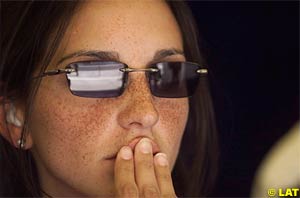 Minardi Team Principal Paul Stoddart was a constant habitue of the Minardi hospitality suite, chain-smoking his way through the weekend and meeting a surprising number of guests that stopped by for a visit to the little team from Faenza, including visitors from American open-wheel racing like Newman Haas team owner Carl Haas and Max Papis, who drives for the David Letterman-Bobby Rahal CART Team and was the only representative of the departed and lamented Bobby Rahal in evidence.
Minardi Team Principal Paul Stoddart was a constant habitue of the Minardi hospitality suite, chain-smoking his way through the weekend and meeting a surprising number of guests that stopped by for a visit to the little team from Faenza, including visitors from American open-wheel racing like Newman Haas team owner Carl Haas and Max Papis, who drives for the David Letterman-Bobby Rahal CART Team and was the only representative of the departed and lamented Bobby Rahal in evidence.
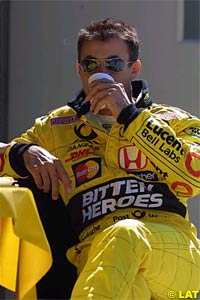 Both of them were in their driver's suits, the tops of the suits rolled down about the waist, about a half hour before the race and passing nearby one another on the second storey of the hospitality suite area, where mere mortals are not allowed. Coulthard came over to Button in a jocular mood, tugged him on the shoulder and blurted out, with no apparent context: "I just wanted you to know that I am braking at 150 [a reference to one of the white braking zone markers at the end of the front straightaway at Indy]", to which Jenson replied, "Good, then I'm braking at 100!" After hearing that, Coulthard wanted to know "what side of the grid are you on," to which Button replied, "I am on the other side from you," much to Coulthard's relief. But you can be sure Coulthard made a mental note to look for the Benetton Blue in his mirrors come the race.
Both of them were in their driver's suits, the tops of the suits rolled down about the waist, about a half hour before the race and passing nearby one another on the second storey of the hospitality suite area, where mere mortals are not allowed. Coulthard came over to Button in a jocular mood, tugged him on the shoulder and blurted out, with no apparent context: "I just wanted you to know that I am braking at 150 [a reference to one of the white braking zone markers at the end of the front straightaway at Indy]", to which Jenson replied, "Good, then I'm braking at 100!" After hearing that, Coulthard wanted to know "what side of the grid are you on," to which Button replied, "I am on the other side from you," much to Coulthard's relief. But you can be sure Coulthard made a mental note to look for the Benetton Blue in his mirrors come the race.
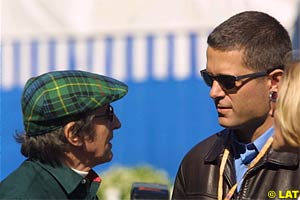 The team principals were also much in evidence in the paddock. Niki Lauda, alone at the top, spent an extraordinary amount of time conferring openly one-on-one with Sir Jackie Stewart, still an eminence grise at Ford-Jaguar. As with Bobby Rahal (the "American Way") and Niki Lauda (the "Austrian Way"), Stewart and Lauda make an Odd Couple, but they seem engrossed with one another, possibly discussing "The Scottish Way". Although I frankly did not see Niki displaying lots of hands-on management at Indy, the Jaguar Team itself was hard at work all weekend (and Eddie Irvine took 4th in the race as a result of Trulli's disqualification); indeed, several of the team members could be seen burning the midnight oil in their hospitality suite the night before the race by converting a hospitality area into a staff working room. Several picnic tables were pushed together to create a sort of crude Ford Motor Company Board Room under field conditions, and there the engineers with their laptops and the mechanics and the team managers discussed the data from the practice and qualifying sessions.
The team principals were also much in evidence in the paddock. Niki Lauda, alone at the top, spent an extraordinary amount of time conferring openly one-on-one with Sir Jackie Stewart, still an eminence grise at Ford-Jaguar. As with Bobby Rahal (the "American Way") and Niki Lauda (the "Austrian Way"), Stewart and Lauda make an Odd Couple, but they seem engrossed with one another, possibly discussing "The Scottish Way". Although I frankly did not see Niki displaying lots of hands-on management at Indy, the Jaguar Team itself was hard at work all weekend (and Eddie Irvine took 4th in the race as a result of Trulli's disqualification); indeed, several of the team members could be seen burning the midnight oil in their hospitality suite the night before the race by converting a hospitality area into a staff working room. Several picnic tables were pushed together to create a sort of crude Ford Motor Company Board Room under field conditions, and there the engineers with their laptops and the mechanics and the team managers discussed the data from the practice and qualifying sessions.
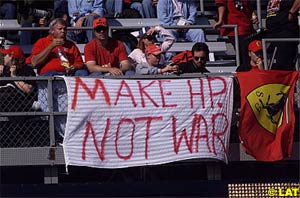 Meanwhile, all along the blacktop of Gasoline Alley, the kibitzing went on among young and old. Arrows driver Brazilian Enrique Bernoldi was introduced by an Arrows team member to Danica Patrick, the young American driver making her way up the ladder to Formula One. When she shook his hand, Bernoldi's eyebrows went up: "firm handshake," he said, as the two went on to discuss where they had each raced, as well as to discuss the "Red Bull" party that evening, one of the sponsors and perhaps future owner of the Arrows team. Bruno Junqueira, a refugee from Chip Ganassi's Target Chip Ganassi CART team, was also in the "see and be seen" mode, circulating through the paddock, as was the father of all Brazilian open-wheel drivers, Emerson Fittipaldi, who always shows up at Indy, having won there twice after being World Champion in Formula One.
Meanwhile, all along the blacktop of Gasoline Alley, the kibitzing went on among young and old. Arrows driver Brazilian Enrique Bernoldi was introduced by an Arrows team member to Danica Patrick, the young American driver making her way up the ladder to Formula One. When she shook his hand, Bernoldi's eyebrows went up: "firm handshake," he said, as the two went on to discuss where they had each raced, as well as to discuss the "Red Bull" party that evening, one of the sponsors and perhaps future owner of the Arrows team. Bruno Junqueira, a refugee from Chip Ganassi's Target Chip Ganassi CART team, was also in the "see and be seen" mode, circulating through the paddock, as was the father of all Brazilian open-wheel drivers, Emerson Fittipaldi, who always shows up at Indy, having won there twice after being World Champion in Formula One.
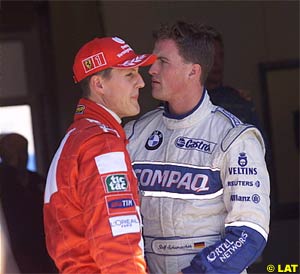 I like both de la Rosa's idea and the Villeneuve spin on it but have my own configuration in mind: take a page from the old Monza track and use much more of the 2.5 mile oval as well as incorporating the twisty bits of the infield into one lap of perhaps 4.5 miles. To assure access of safety vehicles and the Medical Car, most modern Formula One racetracks are about 3 miles, with Spa (4.33 miles) and Hockenheim (4.24 miles currently) the exceptions. But given that the entire Indianapolis Motor Speedway is within a 2.5 mile circumference, taking the Indy track from one of the shortest to the longest would be feasible, would make it more exciting for drivers and fans alike, and would not compromise safety considerations.
I like both de la Rosa's idea and the Villeneuve spin on it but have my own configuration in mind: take a page from the old Monza track and use much more of the 2.5 mile oval as well as incorporating the twisty bits of the infield into one lap of perhaps 4.5 miles. To assure access of safety vehicles and the Medical Car, most modern Formula One racetracks are about 3 miles, with Spa (4.33 miles) and Hockenheim (4.24 miles currently) the exceptions. But given that the entire Indianapolis Motor Speedway is within a 2.5 mile circumference, taking the Indy track from one of the shortest to the longest would be feasible, would make it more exciting for drivers and fans alike, and would not compromise safety considerations.
Please Contact Us for permission to republish this or any other material from Atlas F1.
|
Volume 7, Issue 41
Articles
Villeneuve Strikes Back; Pollock Retaliates
Backyard at the Brickyard
Rating Montoya
Japanese GP Preview
The Japanese Grand Prix Preview
Technical Preview: Suzuka
Columns
Elsewhere in Racing
The Japanese Grand Prix Trivia Quiz
Bookworm Critique
The Weekly Grapevine
> Homepage |